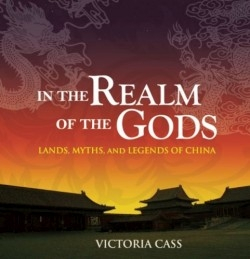In the Realm of the Gods
Lands, Myths, and Legends of China
In her eloquent retelling of this evocative selection of Chinese myths and legends, Victoria Cass (a retired professor of Chinese) transports us into a marvelous, disturbing, and often magical realm. There is a refreshing lack of five-legged dragons and Daoist elixirs of eternal life; the mythical is present in beguiling “shape shifters” (most often foxes and snakes becoming women), disturbing “cloud-spirits” (ghosts), and assorted demons. The time frame runs ca. 500 BC to the twentieth century; the cast includes emperors, travelers, merchants, scholars, peasants, and pilgrims, all facing unpredictable destinies; the book, a handsomely produced 10 x 10-inch volume, marries engaging text to 100 magnificent, well-chosen photographs, many full-page, some double-spread.
China’s physical landscape, fraught with challenge, is Cass’s structural frame, enabling her to produce not a thematic handbook but an eclectic regional sampler: she cites the seventeenth-century writer Zhang Chao’s statement that “…landscape is the literature that lies over the earth,” and also the fourth-century Ge Hong, who, after noting the dangers of high winds and falling rocks, warns that “Mountains are not to be entered lightly.” Mountains, woods, and water are frequent tale-framing elements as Cass leads the reader through China—from the region of the early capital of Chang’an (now Xi’an), to Beijing and Shandong province, to the great cities of Hangzhou, Suzhou and Ningbo in the Yangtze delta region, and then, in the south, to Guilin of the famed crags, before going north to the Yangtze Gorges.
Everywhere landscape is home to a host of ghostly forces and elusive wildlife—the mountain demon, the river spirit, the forest fox and the snake beneath the bridge. All are tricky, able to shift in an instant from benign to malign if unappeased or crossed. The humble peasant who found his hut well tended while he tilled his land managed to meet the fox-visitor, who obligingly became woman and wife. But at a cross word from him she slipped back into her fox skin, picked up the baby-become-cub in her teeth, and was off for good.
Two striking tales pit the weak against the mighty in acts of heroism. To save his tiny state from seizure, Fan Nuqi agreed to a “Great Enterprise”—to decapitate himself and have his head delivered to the rapacious First Emperor so that Jing Ke (“the Master Assassin”), in delivering it, could dispatch the emperor with a hidden dagger. Centuries later, in 1542, Yang Jinying, an abused concubine, attempted to strangle Emperor Jiajing while “riding the fat ox…. a ruthless twist with the Imperial silk cord and the Epochal Ancestor would be another piece of Imperial history.” Both the Master Assassin and the amateur Yang Jinying failed and were executed, but their attempts demolish any simplistic belief in Chinese passivity and blind loyalty. In another tale, self-mutilation wins redemption; an exiled daughter yielded a hand and an eye to make medicine to heal her cruel emperor-father’s “great, pustulous, throbbing cankers”—an act that spurred him become a bodhisattva, a revealer of the True Path.
An awareness of the vicissitudes of life, the rewards of virtue and the punishment of evil underlie several tales. A young woman resists a wealthy suitor; a beggar’s hand upon her cheek ravages her beauty; she is offered marriage by her humble peasant suitor, and is thereafter miraculously restored to her former loveliness by the same beggar’s touch. A depraved and grasping civil servant is anonymously “rewarded” with the lascivious novel *The Plum in the Golden Vase—*whose pages have been impregnated with poison; another is driven into the wilds, unable to escape a lonely death. Particularly haunting is a tale of the passing of the ancient rituals and erotic festivals of the Kingdom of Chu in the Yangzte’s now damned and devastated Three Gorges region.
The Realm of the Gods is a splendid first venture into the vast world of Chinese myth and legend, and Victoria Cass’s excellent introduction, bibliography, and mini-biographies of the seventeen specialist photographers whose work illustrates the book add to its appeal and reward.
Reviewed by
Peter Skinner
Disclosure: This article is not an endorsement, but a review. The publisher of this book provided free copies of the book to have their book reviewed by a professional reviewer. No fee was paid by the publisher for this review. Foreword Reviews only recommends books that we love. Foreword Magazine, Inc. is disclosing this in accordance with the Federal Trade Commission’s 16 CFR, Part 255.

